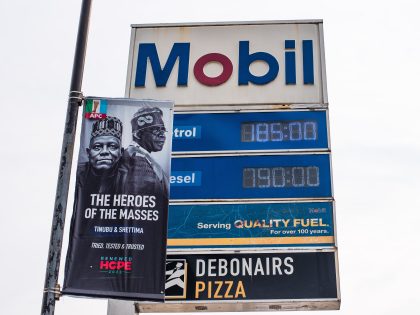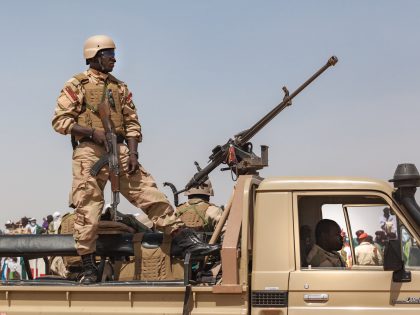My Favorite Photographs: Justine Brabant
Since the mid-1990s, the North and South Kivu provinces of the Democratic Republic of Congo have become battlefields for a myriad of armed groups, a mix of well-organized rebel groups (such as the M23, who surrendered a month ago) confronting the national army, local “autodefense” groups describing themselves as patriotic opponents to theses rebellions, or constituted around some very local issues: land disputes, struggles for customary power and such.
I have been studying armed groups in eastern DRC since 2011, first as part of my political science course, and today as an independent researcher and journalist. I started taking photos incidentally. I was initially reluctant to snap fighters, thinking they would be at best reluctant, if not suspicious and violent – as a white person investigating armed groups, one frequently is suspected of being a spy or some investigator from the International Criminal Court.
But one day some asked me to do so and I gradually discovered that, except in some very rare cases, most of them were rather proud to pose for me as a souvenir at the end of interviews. These fighters are proud because, whatever their group, they sincerely think they fight for a just cause: the protection of their family, of their village, of their country. This pride and this sense of dignity have been a constant subject of questioning since I started researching armed groups. There is no erasing the (sometimes particularly horrific) violence they wage, but maybe it prompts to think beyond the quick descriptors applied to “conflict in Eastern DRC”, a tale of perpetual oppression of civilians by enraged and drunk militiamen.
Zabuloni Rubaruba (center in the first photograph above), is one of the most famous Maï-Maï leaders in South Kivu, and among the first commanders I met. He started fighting against the “Rwandan invasion” in the mid-1990s, and eventually joined the Congolese army as a colonel in 2003. I took this photo in the family house in Bukavu (South Kivu), after an interview with him and his sons in January this year – at that time, I was conducting academic research on “autodefense” armed groups of South Kivu. During the interview, he wore training outfits and looked very tired (he was nearly 80), but for the photo he insisted on wearing his Congolese army uniform and stripes and on standing up. Despite this symbolic recognition, he and his family were manifestly in a precarious financial situation – as a colonel, he earned roughly $80 a month. Of course, some Congolese families struggle to live with less than that, but Zabuloni felt humiliated by his situation in comparison to the public figure he used to be.
I encountered this strong feeling of injustice again when discussing with many other Congolese armed group members, who think that they were never compensated for their “sacrifice” to their country, and don’t understand why the people they fought against (Rwanda-backed rebellions such as RCD and CNDP, seen as “aggressors”) were given better treatments than them in the national army.
The men surrounding Zabuloni include two of his sons, Imany and Sawasawa, respectively meaning “Peace” and “It’s okay” in Swahili. They are not fighters but wanted to pose wearing some of their father military uniforms. Zabuloni said to me he lost seven sons on the battlefield. He died himself two months after I took this picture. The family struggled to find money to pay for the funeral. The Congolese State stopped paying the rent of their Bukavu house, and they had to move to a smaller one. Today, most of his sons are unemployed, and some had to leave university to take up day-to-day jobs with security firms.
One of them, Fujo (“disorder” in Swahili), is still in the bush, leading his own Maï-Maï group. I met him last February, somewhere on the hills overhanging the Plaine de la Ruzizi, a vast plain along the border with Burundi. I arrived at his military camp after sunset, after a 4-hour walk, or should I say run, trying to follow the young men guiding me over these little paths of slippery mud. The arrival at the camp generated a moment of nervousness, with members of Fujo’s escort checking our degree of inoffensiveness by insistently pointing their torches to our faces.
Because of a problem with his phone, Fujo had no idea of my arrival. I was saved by the photo of his father, Zabuloni Rubaruba, that I had taken a few weeks before and that I showed him on my camera. I was also carrying a video message from Zabuloni asking Fujo to leave the bush and come to Bukavu live with the whole family.
Ordinarily I try not to meddle in armed group affairs, but I wasn’t able to decline the request of an old man longing for his family to be reunited. I remember Fujo looked very moved when watching it as he had not seen his father for a couple of years. Before leaving the camp the day after, I took the above photo of some of Fujo’s troops. This picture is a souvenir of this episode, but it also encapsulates features of Maï-Maï groups, often recruiting among the very young and the very old with limited financial means – which is not to say that they are not violent when clashing with their enemies.
Today, Fujo and his men are waiting for negotiations with the Congolese government in order to integrate into the national army.
Numerous Maï-Maï groups practice cattle-raiding. They operate during the transhumance, the seasonal movement of cows from the Mitumba mountain range to the edges of Lake Tanganyika. Cattle-raiding is an important source of funding for armed groups in South Kivu: a cow can sell for up to $500, whereas the gross national income per capita in DRC is $220 per year (according to 2012 World Bank statistics).
In response to attacks against their cattle, some herders of South Kivu created their own local “autodefense groups”. Masomo (meaning “school” in Swahili, a name he was given because he was born on the day the school year started) was the leader of one of these groups between 2008 and 2011.

I met him in 2012 when I was conducting research about agro-pastoral conflicts for a NGO called Life & Peace Institute. We were on the Hauts Plateaux de Minembwe, an important place of livestock farming. Masomo himself used to own cows. All of his stock died of disease but he still walks with his shepherd’s stick. I took this picture of him as we were resting after a long walk in the Minembwe hills, where we met some ex-members of his group. I like the quietness he gives off here. I don’t think this quietness is misleading, I think it simply means we have to admit that, most of the time, armed groups leaders are not dreadful psychopaths but rather ordinary people who decided to take up arms for some reason, and that we (researchers, journalists, and others) have to figure out those reasons.
The Alliance des Patriotes Pour un Congo Libre et Souverain (APCLS), led by Janvier Bwingo, is very different from Masomo’s or Fujo’s groups: more troops, with more substantial equipment, and a sophisticated organization. I met with them last November in their headquarter in Masisi territory, North Kivu. The bridge in the picture below marks the entry into Lukweti, the village where most of their commanders are stationed.

I was crossing over, thinking something about the cleverness of the guys who built it and the beauty produced by the local know-how, when Augustin, the APCLS colonel seen in the background, told me: “During the last attack of the Nduma Defense of Congo [an other Congolese armed group, regularly fighting against APCLS], dozens of children died, drowned in the river, because of this damned unsteady bridge. Can we even call that a bridge?”
This picture is a silent reminder to myself not to be overly enthusiastic about “typical” or “traditional” things. Even if they trigger some salutary questioning about the society we come from, and often turn out great in pictures, the unquestioning celebration of those artifacts can lead to ignoring the claims of decent standards of life.
After meeting the APCLS leader “General” Janvier and some of his men, I decided to go to Pinga, the stronghold of the NDC, their main enemy, to interview their fighters and commanders too. Pinga is a town located 100 kilometers north of Goma, the capital city of the North Kivu province. If you’re a humanitarian worker or a researcher, you can negotiate a seat in one of the MONUSCO (the UN peacekeeping mission in DRC) helicopters flying from Goma to Pinga once or twice a week. I decided to go by road instead, in order to see how life was in the peripheral areas controlled by the NDC. It is always interesting to meet smaller-time commanders — staying far from headquarters — whose biographical backgrounds, motives, discourses and behaviors often differ from their superiors’.
I took the road with Bayomba, a school director, and Françoise, a nurse from Pinga hospital who had to flee to Goma with all her family last August because of heavy fighting between APCLS and NDC. Life in Goma was too hard without a salary (she tried in vain to find a job in one of the Goma hospitals), and she was full of hope, repeating: “I want to go back to our house in Pinga, I’ve been told that it wasn’t burnt down during the war, that’s a good thing.”
The idea was to walk three days in the Walikale forest in order to bypass the most active area of conflict. But on the first day, in the afternoon, we heard the sound of a mortar explosion somewhere in the green hills. It was too late to go back to our starting point; we had no choice but to continue to the next village, Kimba, in order to find out what was going down. In Kimba we met people coming the opposite way than us, fleeing, and telling us that five villages were abandoned by their inhabitants. They heard that NDC troops left Pinga because of rumors of the MONUSCO’s Force Intervention Brigade (FIB) attacking them soon, and these civilians were scared to be caught in fights between the NDC, the APCLS, the Congolese army, the MONUSCO and possibly the Rwandan FDLR (said to stay only 10 kilometers from Pinga). We were there, sitting with Bayomba and Françoise, quite exhausted by our long walk, wondering and debating the different options (the local NDC commander offered us to be escorted by three of his men), and at one point, Françoise sighed: “War is coming back to Pinga. I don’t want to deal with war anymore. I know that too well.” We decided to go back to Goma.
I took this last picture below of Françoise walking through the forest on our way back, the day after. Humanitarian organizations estimate internally displaced persons in the North and South Kivu provinces to number 1,6 million. I hope this kind of photographs helps to imagine a little bit more concretely what theses figures means.

This is the 19th installment in our “5 Favorite Photographs” series in which we ask photographers to select five of their favorite photographs and to describe what brought them to make the image, and what they were trying to convey. Previous features here. More photographs by Justine Brabant here.



















